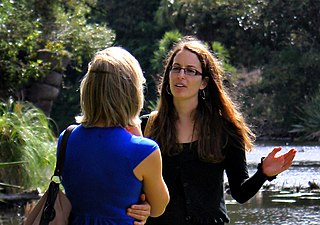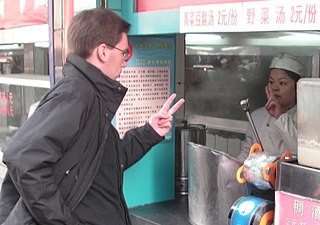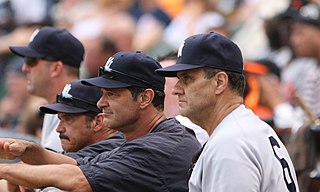
Team building is a collective term for various types of activities used to enhance social relations and define roles within teams, often involving collaborative tasks. It is distinct from team training, which is designed by a combination of business managers, learning and development/OD and an HR Business Partner to improve the efficiency, rather than interpersonal relations.
Rapport is a close and harmonious relationship in which the people or groups concerned are "in sync" with each other, understand each other's feelings or ideas, and communicate smoothly.

Body language is a type of nonverbal communication in which physical behaviors, as opposed to words, are used to express or convey information. Such behavior includes facial expressions, body posture, gestures, eye movement, touch and the use of space. Although body language is an important part of communication, most of it happens without conscious awareness. In social communication, body language often complements verbal communication. Nonverbal communication has a significant impact on doctor-patient relationships, as it affects how open patients are with their doctor. Having open body language, which is typically identified as having a relaxed posture, nodding, eye contact can contribute to patients having higher levels of trust with their doctors. According to, W.Y. Kee, patients who had a doctor that avoided eye contact by looking at a screen or had negative facial expressions contributed to patients feeling dissatisfied after their visit.

Nonverbal communication is the transmission of messages or signals through a nonverbal platform such as eye contact (oculesics), body language (kinesics), social distance (proxemics), touch (haptics), voice, physical environments/appearance, and use of objects. When communicating, we utilize nonverbal channels as means to convey different messages or signals, whereas others can interpret these message. The study of nonverbal communication started in 1872 with the publication of The Expression of the Emotions in Man and Animals by Charles Darwin. Darwin began to study nonverbal communication as he noticed the interactions between animals such as lions, tigers, dogs etc. and realized they also communicated by gestures and expressions. For the first time, nonverbal communication was studied and its relevance noted. Today, scholars argue that nonverbal communication can convey more meaning than verbal communication.

An athletic coach is a person coaching in sport, involved in the direction, instruction, and training of a sports team or athlete.
Intercultural communication is a discipline that studies communication across different cultures and social groups, or how culture affects communication. It describes the wide range of communication processes and problems that naturally appear within an organization or social context made up of individuals from different religious, social, ethnic, and educational backgrounds. In this sense, it seeks to understand how people from different countries and cultures act, communicate, and perceive the world around them. Intercultural communication focuses on the recognition and respect of those with cultural differences. The goal is mutual adaptation between two or more distinct cultures which leads to biculturalism/multiculturalism rather than complete assimilation. It promotes the development of cultural sensitivity and allows for empathic understanding across different cultures.

Social behavior is behavior among two or more organisms within the same species, and encompasses any behavior in which one member affects the other. This is due to an interaction among those members. Social behavior can be seen as similar to an exchange of goods, with the expectation that when you give, you will receive the same. This behavior can be affected by both the qualities of the individual and the environmental (situational) factors. Therefore, social behavior arises as a result of an interaction between the two—the organism and its environment. This means that, in regards to humans, social behavior can be determined by both the individual characteristics of the person, and the situation they are in.
Media richness theory (MRT), sometimes referred to as information richness theory, is a framework used to describe a communication medium's ability to reproduce the information sent over it. It was introduced by Richard L. Daft and Robert H. Lengel in 1986 as an extension of information processing theory. MRT is used to rank and evaluate the richness of certain communication media, such as phone calls, video conferencing, and email. For example, a phone call cannot reproduce visual social cues such as gestures which makes it a less rich communication media than video conferencing, which affords the transmission of gestures and body language. Based on contingency theory and information processing theory, MRT theorizes that richer, personal communication media are generally more effective for communicating equivocal issues in contrast with leaner, less rich media.
The uncertainty reduction theory, also known as initial interaction theory, developed in 1975 by Charles Berger and Richard Calabrese, is a communication theory from the post-positivist tradition. It is one of the few communication theories that specifically looks into the initial interaction between people prior to the actual communication process. Uncertainty reduction theory originators' main goal when constructing it was to explain how communication is used to reduce uncertainty between strangers during a first interaction. Berger explains uncertainty reduction theory as an "Increased knowledge of what kind of person another is, which provides an improved forecast of how a future interaction will turn out". Uncertainty reduction theory claims that everyone activates two processes in order to reduce uncertainty. The first being a proactive process, which focuses on what someone might do. The second being a retroactive process, which focuses on how people understand what another does or says. This theory's main claim is that people must receive information about another party in order to reduce their uncertainty and, that people want to do so. While uncertainty reduction theory claims that communication will lead to reduced uncertainty, it is important to note that this is not always the case. Dr. Dale E. Brashers of the University of Illinois argues that in some scenarios, more communication may lead to greater uncertainty.
Interpersonal deception theory (IDT) is one of a number of theories that attempts to explain how individuals handle actual deception at the conscious or subconscious level while engaged in face-to-face communication. The theory was put forth by David Buller and Judee Burgoon in 1996 to explore this idea that deception is an engaging process between receiver and deceiver. IDT assumes that communication is not static; it is influenced by personal goals and the meaning of the interaction as it unfolds. IDT is no different from other forms of communication since all forms of communication are adaptive in nature. The sender's overt communications are affected by the overt and covert communications of the receiver, and vice versa. IDT explores the interrelation between the sender's communicative meaning and the receiver's thoughts and behavior in deceptive exchanges.

Social information processing theory, also known as SIP, is a psychological and sociological theory originally developed by Salancik and Pfeffer in 1978. This theory explores how individuals make decisions and form attitudes in a social context, often focusing on the workplace. It suggests that people rely heavily on the social information available to them in their environments, including input from colleagues and peers, to shape their attitudes, behaviors, and perceptions.
The hyperpersonal model is a model of interpersonal communication that suggests computer-mediated communication (CMC) can become hyperpersonal because it "exceeds [face-to-face] interaction", thus affording message senders a host of communicative advantages over traditional face-to-face (FtF) interaction. The hyperpersonal model demonstrates how individuals communicate uniquely, while representing themselves to others, how others interpret them, and how the interactions create a reciprocal spiral of FtF communication. Compared to ordinary FtF situations, a hyperpersonal message sender has a greater ability to strategically develop and edit self-presentation, enabling a selective and optimized presentation of one's self to others.
Social presence theory explores how the "sense of being with another" is influenced by digital interfaces in human-computer interactions. Developed from the foundations of interpersonal communication and symbolic interactionism, social presence theory was first formally introduced by John Short, Ederyn Williams, and Bruce Christie in The Social Psychology of Telecommunications. Research on social presence theory has recently developed to examine the efficacy of telecommunications media, including SNS communications. The theory notes that computer-based communication is lower in social presence than face-to-face communication, but different computer-based communications can affect the levels of social presence between communicators and receivers.
Judee K. Burgoon is a professor of communication, family studies and human development at the University of Arizona, where she serves as director of research for the Center for the Management of Information and site director for the NSF-sponsored Center for Identification Technology Research. She is also involved with different aspects of interpersonal and nonverbal communication, deception, and new communication technologies. She is also director of human communication research for the Center for the Management of Information and site director for Center for Identification Technology Research at the university, and recently held an appointment as distinguished visiting professor with the department of communication at the University of Oklahoma, and the Center for Applied Social Research at the University of Oklahoma. Burgoon has authored or edited 13 books and monographs and has published nearly 300 articles, chapters and reviews related to nonverbal and verbal communication, deception, and computer-mediated communication. Her research has garnered over $13 million in extramural funding from the National Science Foundation, the Department of Defense, the Department of Homeland Security, the Office of the Director of National Intelligence, Counterintelligence Field Activity, and the National Institutes of Mental Health. Among the communication theories with which she is most notably linked are: interpersonal adaptation theory, expectancy violations theory, and interpersonal deception theory. A recent survey identified her as the most prolific female scholar in communication in the 20th century.
Sport psychology is defined as the study of the psychological basis, processes, and effects of sport. Sport is defined as any physical activity where the individuals engage for competition and health. Sport psychology is recognized as an interdisciplinary science that draws on knowledge from many related fields including biomechanics, physiology, kinesiology and psychology. It involves the study of how psychological factors affect performance and how participation in sport and exercise affect psychological, social, and physical factors. Sport psychologists teach cognitive and behavioral strategies to athletes in order to improve their experience and performance in sports.

Interpersonal communication is an exchange of information between two or more people. It is also an area of research that seeks to understand how humans use verbal and nonverbal cues to accomplish several personal and relational goals. Communication includes utilizing communication skills within one's surroundings, including physical and psychological spaces. It is essential to see the visual/nonverbal and verbal cues regarding the physical spaces. In the psychological spaces, self-awareness and awareness of the emotions, cultures, and things that are not seen are also significant when communicating.

Verbal aggressiveness in communication has been studied to examine the underlying message of how the aggressive communicator gains control over different things that occur, through the usage of verbal aggressiveness. Scholars have identified that individuals who express verbal aggressiveness have the goal of controlling and manipulating others through language. Infante and Wigley defined verbal aggressiveness as "a personality trait that predisposes persons to attack the self-concepts of other people instead of, or in addition to, their positions on topics of communication". Self-concept can be described as a group of values and beliefs that one has. Verbal aggressiveness is thought to be mainly a destructive form of communication, but it can produce positive outcomes. Infante and Wigley described aggressive behavior in interpersonal communication as products of individual's aggressive traits and the way the person perceives the aggressive circumstances that prevents them or something in a situation.
Misogyny in sports includes different discourses, actions, and ideologies present in various sporting environments that add, reinforce, or normalize the objectification, degrading, shaming, or absence of women in athletics.
Athletic identity is a part of self-identity and can be defined as the level, to which one identifies with the role of an athlete. It is a self-concept that is constructed from information processed by the individual and influences both input and output of information related to the self. For athletes and people that are actively involved in sports, athletic identity is a major part of their self and they can satisfy the need of their athletic identity by taking part in sports. Athletic identity increases with the level of involvement in sports, and strong athletic identity correlates positively with athletic achievements, as well as with higher motivation and competitiveness. Changes, such as a decline, in athletic identity facilitate adjustment to everyday life.
Sally A. Shaw is a British–New Zealand academic, and is a full professor at the University of Otago, specialising in diversity, inclusion and gender issues in sports and sport management.










